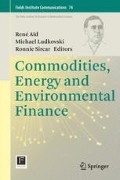Abstract
Commodity exchange-traded funds (ETFs) are a significant part of the rapidly growing ETF market. They have become popular in recent years as they provide investors access to a great variety of commodities, ranging from precious metals to building materials, and from oil and gas to agricultural products. In this article, we analyze the tracking performance of commodity leveraged ETFs and discuss the associated trading strategies. It is known that leveraged ETF returns typically deviate from their tracking target over longer holding horizons due to the so-called volatility decay. This motivates us to construct a benchmark process that accounts for the volatility decay, and use it to examine the tracking performance of commodity leveraged ETFs. From empirical data, we find that many commodity leveraged ETFs underperform significantly against the benchmark, and we quantify such a discrepancy via the novel idea of realized effective fee. Finally, we consider a number of trading strategies and examine their performance by backtesting with historical price data.
Access this chapter
Tax calculation will be finalised at checkout
Purchases are for personal use only
Notes
- 1.
According to ETF Database website (http://www.etfdb.com/compare/volume).
- 2.
In 2009, the SEC and FINRA issued an alert on the risk of leveraged ETFs on http://www.sec.gov/investor/pubs/leveragedetfs-alert.htm.
- 3.
For more details on the issue of storage cost for commodity ETFs, we refer to the Morningstar Report: “An Ugly Side to Some Commodity ETFs” by Bradley Kay, August 19, 2009.
- 4.
For a detailed snapshot of the holdings for a proshares ETF, please see http://www.proshares.com/funds/XYZ_daily_holdings.html where {XYZ} is the ETF ticker.
References
Ahn, A., Haugh, M., Jain, A.: Consistent pricing of options on leveraged ETFs. Working Paper, Columbia University (2012)
Avellaneda, M., Zhang, S.: Path-dependence of leveraged ETF returns. SIAM J. Financ. Math. 1, 586–603 (2010)
Cheng, M., Madhavan, A.: The dynamics of leveraged and inverse exchange-traded funds. J. Invest. Manag. 7(4), 43–62 (2009)
Dobi, D., Avellaneda, M.: Structural slippage of leveraged ETFs. Working Paper (August 2012)
Guedj, I., Li, G., McCann, C.: Futures-based commodities ETFs. J. Index Invest. 2(1), 14–24 (2011)
Leung, T., Li, X.: Optimal mean reversion trading with transaction costs and stop-loss exit. J. Theoretical & Applied Finance 18(3), p. 1550020 (2015)
Leung, T., Santoli, M.: Leveraged exchange-traded funds: admissible leverage and risk horizon. J. Invest. Strateg. 2, 39–61 (2013)
Leung, T., Sircar, R.: Implied volatility of leveraged ETF options. Applied Mathematical Finance, 22(2), pp. 162–188 (2015). http://www.tandfonline.com/eprint/jt8MFtBFhkjMIPDYiS9E/full
Mackintosh, P., Lin, V.: Longer term plays on leveraged ETFs. Credit Suisse: Portfolio Strategy, pp. 1–6 (April 2010)
Mackintosh, P., Lin, V.: Tracking down the truth. Credit Suisse: Portfolio Strategy, pp. 1–10 (February 2010)
Mason, C., Omprakash, A., Arouna, B.: Few strategies around leveraged ETFs. BNP Paribas Equities Derivatives Strategy, pp. 1–6 (April 2010)
Murphy, R., Wright, C.: An empirical investigation of the performance of commodity-based leveraged ETFs. J. Index Invest. 1(3), 14–23 (2010)
Naylor, M., Wongchoti, U., Gianotti, C.: Abnormal returns in gold and silver exchange traded funds. J. Index Invest. 2(2), 1–34 (2011)
Triantafyllopoulos, K., Montana, G.: Dynamic modeling of mean-reverting spreads for statistical arbitrage. Comput. Manag. Sci. 8, 23–49 (2009)
Acknowledgements
The authors would like to thank Scott Weiner of VelocityShares, and the participants of the 2013 Focus Program on Commodities, Energy and Environmental Finance held at Field’s Institute and the 2014 Joint Mathematics Meetings in Baltimore for their helpful suggestions and comments.
Author information
Authors and Affiliations
Corresponding author
Editor information
Editors and Affiliations
Rights and permissions
Copyright information
© 2015 Springer Science+Business Media New York
About this chapter
Cite this chapter
Guo, K., Leung, T. (2015). Understanding the Tracking Errors of Commodity Leveraged ETFs. In: Aïd, R., Ludkovski, M., Sircar, R. (eds) Commodities, Energy and Environmental Finance. Fields Institute Communications, vol 74. Springer, New York, NY. https://doi.org/10.1007/978-1-4939-2733-3_2
Download citation
DOI: https://doi.org/10.1007/978-1-4939-2733-3_2
Publisher Name: Springer, New York, NY
Print ISBN: 978-1-4939-2732-6
Online ISBN: 978-1-4939-2733-3
eBook Packages: Mathematics and StatisticsMathematics and Statistics (R0)

